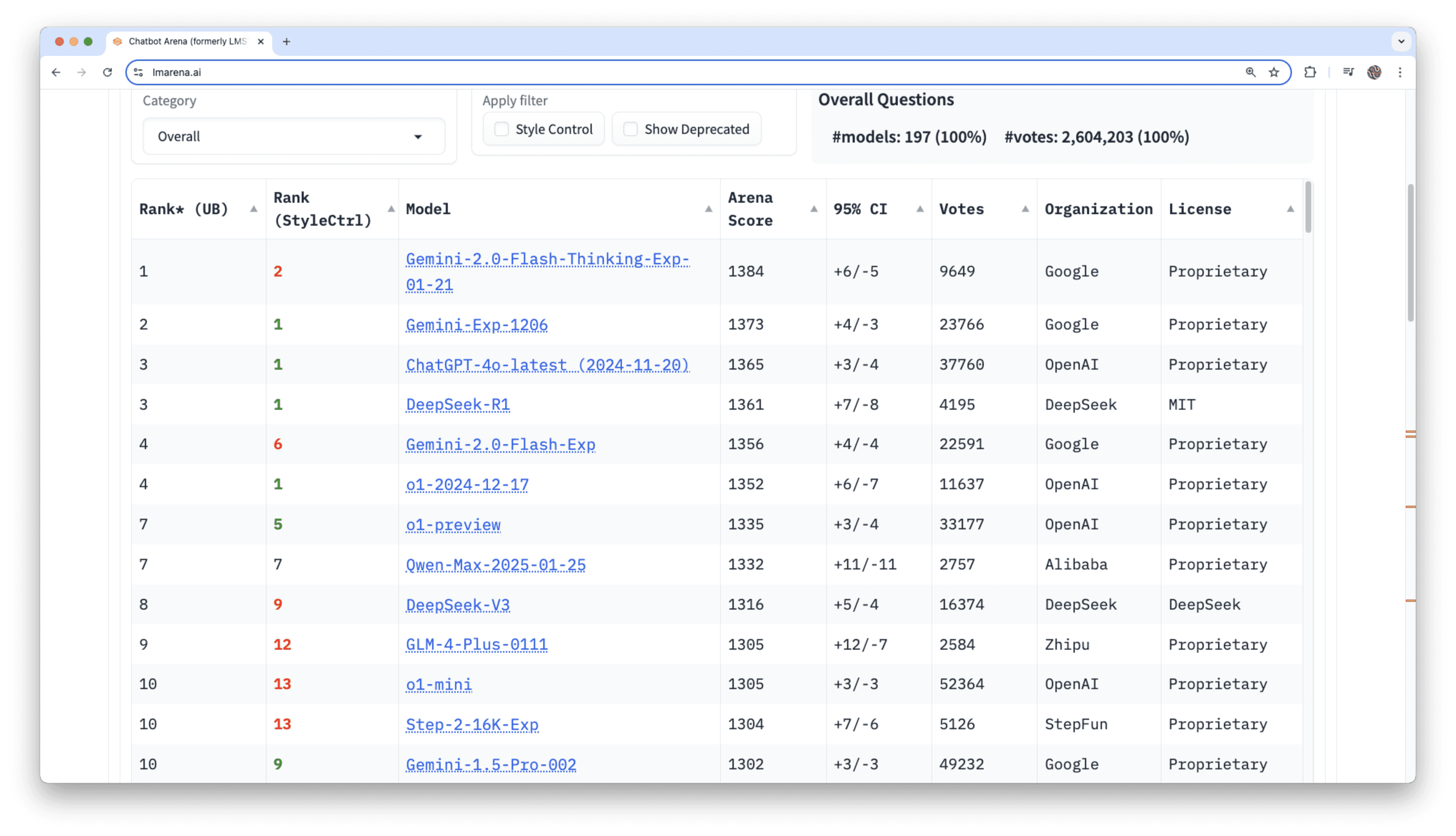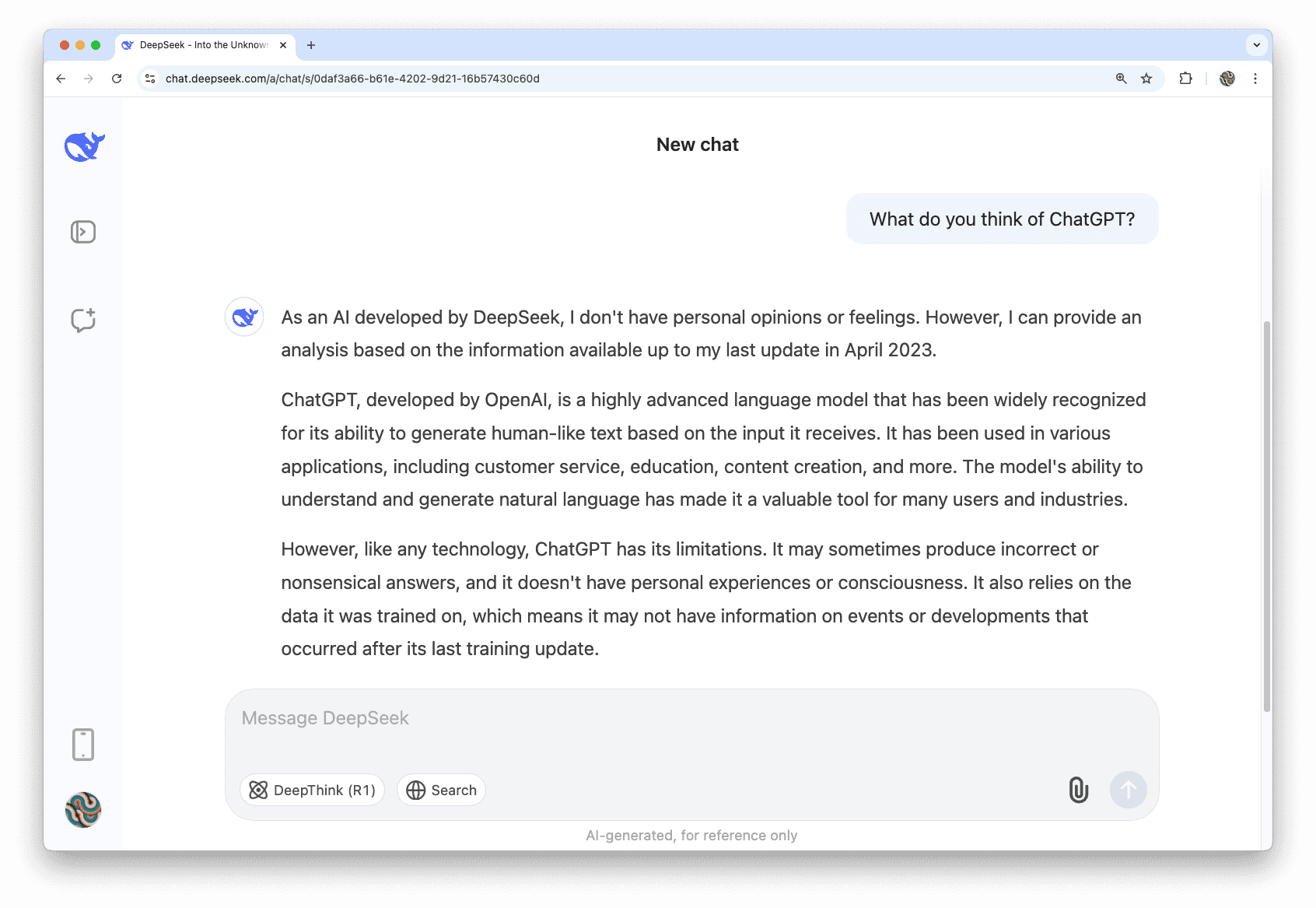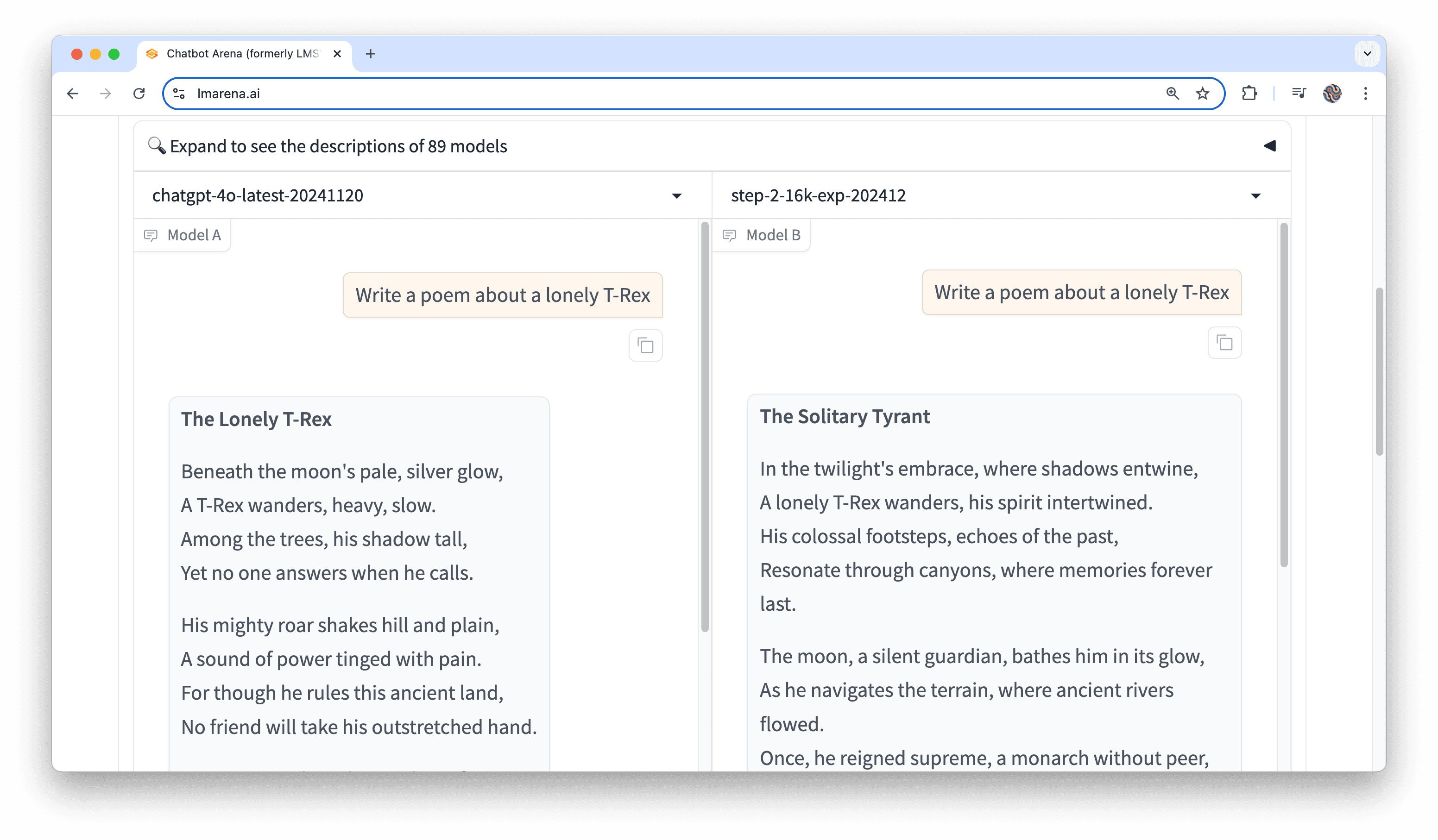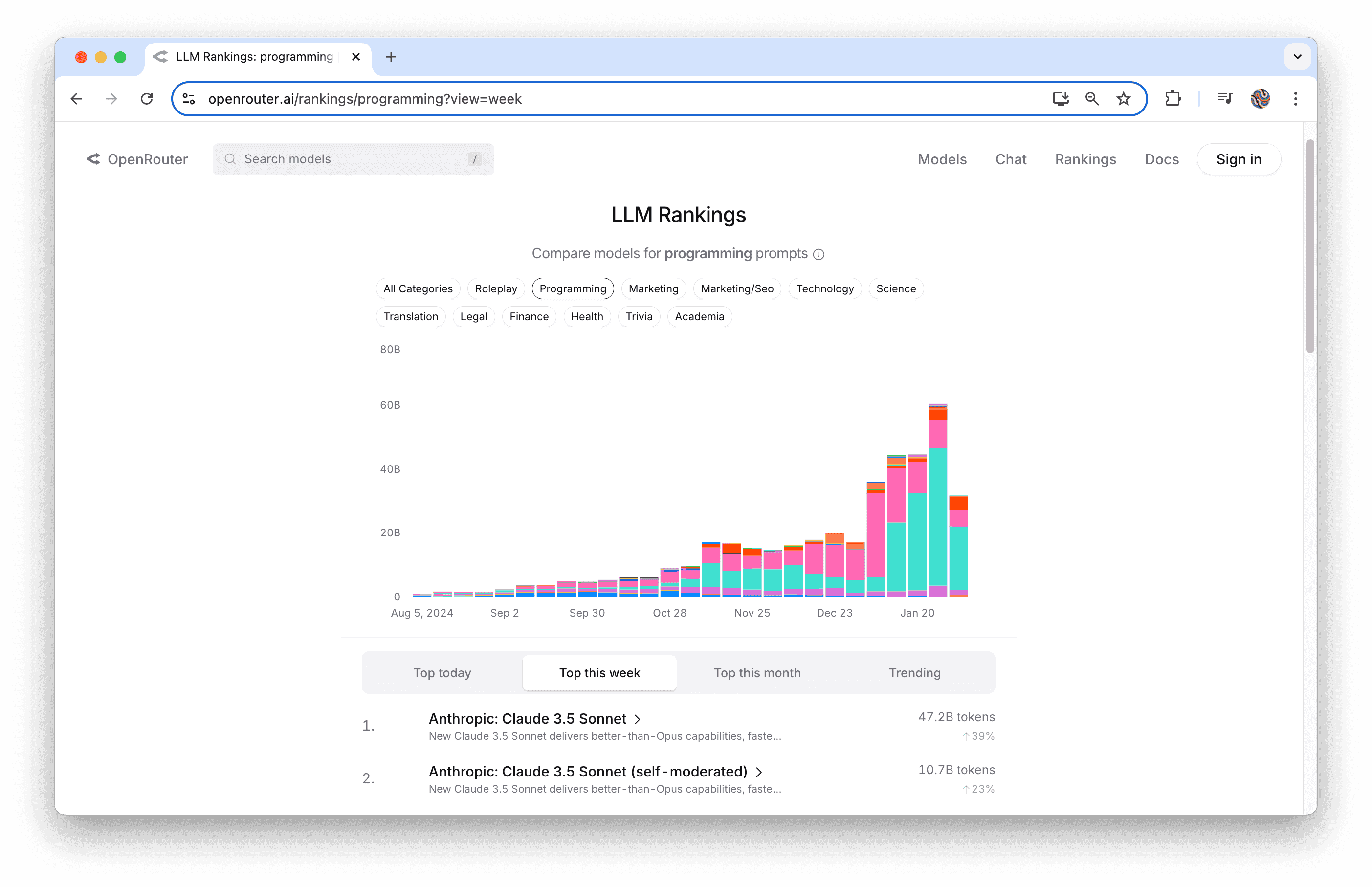Feb 6, 2025
Read our detailed guide to LLM comparison: explore AI leaderboards, benchmarks, and tools to analyze models by speed, quality, price, and performance.
If you want to use AI chatbots more and better in your work and everyday life, you may be already annoyed by the sheer number of available models and tools. It seems that every month, a new AI model is popping up and each outplays others in abilities, exceeding benchmarks. GPT 4o was a huge leap, then o1 for reasoning tasks, coding and math, a few weeks later – updates version of Claude Sonnet 3.5 for coding was released as well. Recently, DeepSeek R1 has literally broken the market and seems to be leading the way right now.
Let's look at AI benchmarks and leaderboard. The most popular and advanced AI providers at the moment are ChatGPT from OpenAI, Gemini from Google, Claude from Anthropic, and DeepSeek. Don't forget about Qwen by Alibaba, LLama by Meta, and Mistral breathing down the necks of leaders.

I will explain and compare the top models and its features here as well. Also, we will see whether image generating AI models (DALLE-3, Stable Diffusion, Midjourney, Flux Pro) can be compared and how can they be used together in a simple way. The final answer to this overall comparison will not be obvious and predictable, so read till the very end.
Let us see, how to choose a model that would be a good fit for your needs and tasks. We will also learn how to compare models with each other, not just on common benchmarks, but with your specific tasks. By comparing features, security, abilities and costs you will surely find a right model for you, or even multiple models to use in a sustainable way.
Features and Performance
Chat GPT-4o
What is an AI model that started it all for most people? It is ChatGPT, with its 4o as its most recent iteration. ‘O’ here stands for GPT 4 'Omni', a better version of model four. But is it all that good? Maybe other models are cheaper… and faster? What if GPT is just the most popular and not the most useful? We need to elaborate on this, first, by looking at its example use cases, which are:
Writing texts, answering questions and overall text content creation. This is basically the same task and, given an ability of 4o to search the web in an efficient way, GPT does that well enough.
Customer support. Many companies and initiatives, for example Parloa, started using 4o as soon as it hit the market. There are other alternatives that are widely used in customer service and for chatbots on websites. GPT is flexible enough and well-rounded, but it is seems to be often pricey and generic. My line here is: people often can notice it is GPT, and that the answer was written by GPT 4o. It is just the model people use most often and its stile became what people call “mid”.
Coding. Frankly, OpenAI has already made a model that is much better in coding then 4o. It is called OpenAI o1 and it codes and solves math way better. Still, GPT can code, it does basic coding tasks and would be enough if you want to write some html code, some short fragment of Python or an insert to your Java project. The main thing is, of course, to prompt it well.
With the fact that GPT is so widely used, its performance should be great, right? It is, for most uses. You can use it in large newsrooms, you can code amateur applications or even professional ones (but slower), you can add GPT to your application or service, and, having a costly subscription, you can generate images, search the web, and do much more with much less limits. On a free plan, you will have GPT4o limit hit in every 5 minutes of work or so.
DeepSeek R1
When R1 model first came out on Christmas 2024, it did not break headlines and was not too loud, everyone was busy with Holidays, families and presents. But in the beginning of 2025, when it seemed that the model is (more or less) 10 times cheaper than OpenAI GPT-4o for its worth, the media was all about this model. An app and web service was released with the help of Chinese large hedge-fund HighFlyer. It started to be a top app in AppStore and one of the top search results. People wanted to 比较 DeepSeek to GPT, to Claude or to Gemini, other top AI models that have been leading last year. Again, is it all that great? What can you do with it? Is it just media fluff or you should switch to DeepSeek LLM?
It is a reasoning model, so, it works very similar to GPT-4o and produces results with similar parameters. It matters from a consumer side, because, if you know how to prompt and to use GPT-4o, you will get used to R1 model from start. Should you switch?
In my opinion, not yet. It speed and performance are similar, it does content creation, coding and works with API in a similar way that GPT does. What is phenomenal about it is its price if you are business client and the fact that it is a whole new AI model in 2025, developed for much less investment than any other popular LLMs.

You can try and play with this model here: https://www.deepseek.com/ . Keep in mind that GPT will still be more predictable and (perhaps) productive for your work. Or will it be other model, like Gemini or Claude? Let’s analyse.
Gemini 2.0
This project became known and used as Bard chatbot, now it is already a second version of Gemini. As you will see, it deals with customer support in a more active manner; it maintains context of conversations longer, and those two features are connected. Examples of use that I think are the best here:
Adding Gemini-based chatbot to your service and website. Because it knows and remembers context well, searches through its databases in a fast way, you may be surprised at how it does something in line of customer support.
When GPT “learned” to search online, most other consumer advantages of Gemini have became… not so needed, but not for Android users. This AI model becomes more and more integrated with the most popular mobile OS and is now widely used.
For developers, Gemini is integrated brilliantly with Android Studio. That means that when you develop an app for Google Play, you can easily try AI functionality with it. And with new versions of Android rolling out and with Apple Intelligence being a pressing rival, Gemini can now go down that road as well. It may be better suited to assist in everyday life, it is used in applications that mnage schedules or or plan out your tasks.
In regards to performance, there are two versions and they differ. There is “Pro” and “Flash”, and as the name suggests, you can achieve more with the first one. I analyzed its benchmarks, but again, they make sense mostly if you are a developer. Pro model wins with a slight advantage. In day-to-day tasks, you will probably not notice the difference all that much.
Claude 3.5 Sonnet
What about the other popular model called Claude? It is made by Anthropic and the word to describe it would be ‘ethics’. It avoids biased, harmful and sensitive topics, helps to learn, and is good for relevant use cases. For example:
Mental Health. You can either use this for your own mental stability or to build applications (or web services) with that focus.
Ethics, Education, NGO’s. Working with sensitive groups and with sensitive subjects, you may find Claude abilities, style and even design quite friendly and appealing. If you are a developer and want to build on top of a model, you will also find that it is built so that it is limited “in the right ways” when it comes to such uses. But with that, comes the fact that it is much less generic and wide-used then GPT is, and, with models like DeepSeek, the pricing of Claude may not make too much sense now.
Here I am attaching a screenshot of how Claude performs, especially in comparison with GPT 4o and Gemini. You can see that in many knowledge-based tasks it is slightly better, but this comparison was done by Claude developers. Can you compare those models by yourself?
AI for Images
Before giving you a way to compare, I also want to touch upon making pictures. There are now three decent models for generating images. Fist one is DALLE-3 by OpenAI. Dalle is very popular because it's integrated in ChatGPT, though it is not as swift as you may think.
Second model is an advanced, professional-grade Stable Diffusion by Stability AI. It is free, but it has so much plugins that you can do almost anything with it. Animations, hundreds of styles, assets for game design, training the model on your own artistic work, and much more. It, however, requires more technical skill and some time to learn. You can use it through DreamStudio, and in it, Stable Diffusion is very limited. Or you can download it, go through some work with Python and other dull applications, and get it working offlin on your own PC. If you are a simple user, I would suggest using a simple web interface and to think whether you need StableDiffusion at all.
Third model is Flux1.1 Pro, a quite recent advancement, that has its own distinct style and looks very professional from the start. In my opinion, this is the most advanced text2image model currently available on the market in 2025. Why do I think so? It makes pictures that are much less generic than those of DALLE-3. It is much easier than Stable Diffusion and has less of work to be done to be set and ready. Just look at this realistic but artificial image created with Flux:

Pricing of AI Models
At first, it may seem that you can use AI for completely free. GPT-4o is now available to try; you can find some limited AI image generators, you can even generate some three-second videos with Luma Machine for free. However, when it is less about play and try out and more about daily use, you begin to kick walls around those limits that you start to have. So, how much do AI subscriptions cost?
GPT-4o price is 20$ a month. That gives you an ability to use that LLM with much less limits and to generate DALLE-3 images, which serve as illustrations, but which are often generic and boring. Even with best prompts in mind, it is just more limited than Stable Diffusion, that is why I rarely use it for “real stuff”.
What about Claude? It is similar, 18$ per month for a less limited version, Pro. You will pay 25$ for a Team plan. With those two, you can have more usage, you will be able to use more models, like Opus and other previous by Anthropic. You will be able to organize projects in a simpler way. Besides that, you get early access to new features. If you are a hardcore enthusiast, maybe Claude subscription is worth it. For educators, facilitators, and other people who may have specific Claude use cases, it may be an option as well.
Gemini is free for basic things, but Gemini Advanced costs $25 monthly. For Gemini API usage you will probably have to pay more. Now, let us count! For three of those models, you already have 63$ each month, if you want to compare them all on your projects and with your practice. If you do need to generate pictures and want to see how Flux and Stable Diffusion work not on one or two images, but with what you have in mind, you need to count that as well. Is there another solution? There explore two platforms with AI comparison functionality, each with a different attitude.
Comparing AI Models Side by Side
There are now two simple projects that let you to compare the performance of AI models that you choose. First one is quite theoretical but very useful, and the second one is very practical, that you can use day to day on many tasks of yours.
Writingmate
Writingmate main feature is the access to dozens of AI models in a single web app, in a cost of one subscription, with a free trial. That tool includes GPT-4o, GPT-4o Mini, OpenAI’s o1, Claude 3.5 Sonnet, Gemini 2.0 Pro, and much more. You pay once and get full and unlimited access to all of those professional models, 20$ a month not just for GPT-4o or for a single Claude, but for every popular AI model. You also get a prompt library, text-to-speech, chatting with files, bots and custom assistants, and more.
But the feature that interests me here today is Model Comparison, and Writingmate lets to compare models side by side on your exact tasks. You can use Split Screen Model Comparison by logging into Writingmate, then selecting this option from the left menu. Then, you just set two models that you choose, give them a prompt to work on, and see how well they perform against each other.
This is a video of Writingmate LLM Comparison feature in action:
Chatbot Arena
The next tool is Chatbot Arena. It allows you compare all popular models and even make blind tests between different LLMs. There are also trustworthy leaderboards managed by experienced AI community, split by categories. Very convenient!

OpenRouter
OpenRouter is worth mentioning by two reasons. First of all, this is a platform that allows you to get paid access to API of dozens of top LLMs having a single account registered. Secondly, OpenRouter provides LLM Rankings with nuanced comparison and statistics. Rankings are split by categories to check the leaders in different niches, such as Programming or SEO Marketing.

Summing Up
In this article, we have compared all of the best AI models, their use cases, areas where they shine, and found ways to technically and simply compare models inside a web application. Let it be useful to you, and try this out. As you see, different models excel in different kinds of tasks, have their own advantages and disadvantages. Make sure you know what model to use and when, whether you are an individual novice user, an enthusiast, or a developer.
In the end, I would like you to watch a detailed comparison of two AI top models making huge waves right now, and also leave some useful links for you. Till the next article!
Useful Links:
Writingmate Manual: All supported models
DeepSeek-R1: Official release notes
OpenRouter: List of available models






